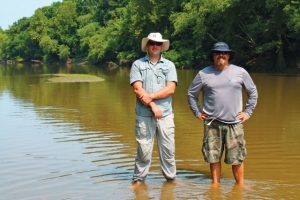Riverkeepers hope to protect Neuse from seepage
By Ethan Smith
Published in News on July 26, 2014 11:46 PM

Matthew Starr and Travis Graves, members of the Neuse Riverkeeper \nFoundation stand in the water. The men are concerned with the quality \nof water — and are fighting to protect the wildlife that lives in the \nhabitat.
Matthew Starr of the Neuse Riverkeeper Foundation was floating down the Neuse River in his kayak when he noticed something strange flowing into the water.
What he saw was a mysterious orange seepage near the site of the former H.F. Lee power plant facility.
Starr believes that it is illegal seepage from the facility's coal ash pond. Duke Energy, the owner of the property, says there is no seepage in the area and that the discolored water is being tainted by iron deposits, not coal ash pond seepage.
Starr disagrees.
"This isn't surface water flowing into the river," Starr said. "It hadn't rained in days when I was going down the river, and still this orange seepage is flowing off the bank and into the water."
According to Erin Culbert, a Duke Energy spokesperson, the seepage is coming from a ditch near one of the coal ash ponds.
"Plant employees walked the area and did not observe any unusual seepage from the ash basin to the ditch," Culbert said. "The orange color is caused by iron bacteria, naturally occurring and non-harmful bacteria that occur commonly in this area because of iron-rich soils."
Unusual seepage is identified as anything that does not occur as part of normal functioning of the dams that prevent the ponds from flowing into the river. The inspection teams search for any wet spots, depressions or changes in the dam slope that could indicate dam safety concerns, Culbert said.
Despite this, Starr is still concerned, and he said this seepage is not the only one of its kind.
"If the Duke employees just walk the grounds, there's no way for them to see the seepage," Starr said. "You have to be on the river in order to see it."
Duke Energy's permit with the state allows for discharges into the Neuse River at what is labeled as Outfall 001.
"None of the photos I took that day were of seeps coming from the outfall," Starr said. "When I was on the river, it was so low that the outfall was actually about eight feet above my head."
Culbert did admit that some amount of seepage is necessary for an earthen dam's structural integrity. But according to a recent Notice of Intent filed by the Southern Environmental Law Center on behalf of Starr, the structural stability of these ponds is in danger, and Duke Energy has violated seepage standards set by state government at least 279 times between 2010 and 2013.
"Duke permanently closed the coal-burning units at the Lee coal-fired power plant in 2012," the Notice of Intent reads. "However, the Lee coal ash pits and lagoon continue to discharge pollutants illegally into the Neuse River and present a constant threat to the people and the environment downstream."The Lee site has one unlined coal ash pond, which was constructed in the 1980s and is situated on the bank of the Neuse in a flood plain. This pond spans 143 acres and the ash in the pond is kept in a wet state, causing potential for unpermitted seepage, according to the notice of intent filed by the Southern Environmental Law Center. There are three other inactive coal ash ponds at the site that were constructed in the 1950s and 1960s on the banks of the Neuse and still hold coal ash.
According to the Southern Environmental Law Center, the coal ash ponds are constructed in wetlands along the Neuse, making them prone to flooding, as several streams run through the inactive ponds at the facility.
"As someone who works hard to keep the river safe, there's just a lot going on right now that leaves out the concerns of a lot of people," Starr said.
